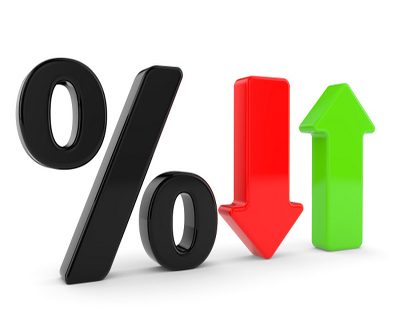Interest Rates For Dummies
That title is misleading. I am not saying you are dumb because you aren’t. But interest rates can be confusing and difficult to understand. In fact, even most bankers and lenders do not understand how they work. As a result, most people just think, “I want the lowest interest rate” without knowing exactly why.
I am not here to bash the banks – they do provide a great service for the American public. I just want to help you understand how interest rates work so you might be able to put yourself in the position of the bank. Have you ever heard me talk about Becoming Your Own Banker?
History is a great teacher so let’s look at it for a moment. Back in the early 1980s you could get 9% interest on a certificate of deposit. It would cost you 15% to borrow money from a bank. What was the bank’s profit if they loaned you the money to invest in the CD? Almost without exception, people will say 6% (because 15%-9%=6%). That answer is incorrect, but reveals an all too common misunderstanding. Before I give you the correct answer, let me simplify this question into dollar amounts.
Imagine you go into the bank and deposit $100 dollars on January 1st. Given the interest rate, by December 31st the bank would have paid you $9. Put a different way, the bank rented your $100 for 1 year for a cost of $9. Now ask yourself, “did the bank just put your money in the vault and let it stay there the whole year?” No, of course not. What actually happened was on the same day you rented your $100 to the bank, the bank had someone who wanted to borrow (rent) $100 from them. The new borrower paid the bank $15 over the course of the same year to use that $100. Ok, let’s ask the original question again, “What is the bank’s profit on that transaction?” This time, most people will answer $6 ($15-$9=$6). But using these dollar amounts what was the bank’s profit in percentages? The math is, profits ÷ cost = % profit, i.e. 6 ÷ 9 = 66.67%. Yes, you read that correctly the bank’s profit was 66.67% on that transaction.
As a side note, what made this all possible was you. Think about it, if the bank used its own money to lend to the borrower their profit would only have been 15%. Why would anyone use their own money and make 15% when they can get someone else to give them money and make 66.67%? But we need to get back to our story.
By the late 1980s there was the S&P crisis as well as a ton of bank failures. How is it a business that was making 66.67% profit on every transaction go bankrupt? Well it happened in record numbers. What was the solution? Alan Greenspan rode into town to save the day. He understood things so he said, “lower the interest rates.” Actually he want to make money for affordable for consumer, i.e. borrowers. Did he ever, interest rates dropped to around 3% on a certificate of deposit. The banks maintained their 6% spread and were lending money out at 9%. Most people, including the people working in the banks, thought nothing had changed, they were still making 6%. But why was it that within a very short time frame banks were posting record profits? Before I give you the answer, let me simplify this question into dollar amounts.
Imagine you go into the bank and deposit $100 dollars on January 1st. By December 31st the bank would have paid you $3. Put in a different way the bank rented your $100 for 1 year for a cost of $3. Now ask yourself, “did the bank just put your money in the vault and let it stay there the whole year?” No, of course not. What actually happened was on the same day you rented your $100 to the bank, the bank had someone who wanted to borrow (rent) $100 from them. The new borrower paid the bank $9 by December 31st to have that $100. Ok, let’s ask the original question again, “What is the bank’s profit in this transaction?” This time most people will answer $6 ($9-$3=$6). Okay, now using these dollar amounts what was the bank’s profit in percentages? The formula to solve for percentage of profit is profits ÷ cost = % profit, i.e. 6 ÷ 3 = 200%. Yes, you read that correctly. The bank’s profit was 200% on that transaction. How many companies would post record profits if their profits per transaction increased from 66.67% to 200%?
There is an unspoken assumption we have made that the borrower always pays the money back. What happens when the borrowers cannot pay back the money? Then the banks are considered unstable and depositors want their money back. The bank can become insolvent very quickly. That is exactly what happened in the late 1980s and early 1990s. There were many borrowers not paying their loans back. Fast forward to the first decade of this century, the 2000s when banks lent money to anyone and everyone. The problem that became apparent in 2008 was the banks forgot about crucial step of ensuring borrowers would be able to repay their loans. Once again, there was a crisis and the banks were in trouble. What was the magic answer? Lower the interest rates.
What was the result of the crisis? Do you remember the huge bonuses bankers were paying themselves in 2008 and 2009? How did the banks get all that money to pay those bonuses? Yes a lot came from the bailout gift the American tax payer gave them, but more significant still, was the change in interest rates.
This time let us use numbers from 2016 when you could get a loan from the bank for about 4%, but you could earn interest on a certificate of deposit of only 0.25% – and that’s if you were lucky. This time imagine you deposited $100 dollars on January 1st 2016. By December 31st, 2016 the bank would have paid you $0.25. The bank simply rented your $100 for 1 year for $0.25. By now you know the scenario. A new borrower paid the bank $4 by December 31st, 2016 to have that $100. The employees at the bank would tell you they lowered their interest rate spread because they cared about you, the consumer. Ok, let’s ask the question again, “What is the bank’s profit in this case?” Sorry to do this to you, but repetition is the mother of learning. This time most people will answer $3.75 ($4-$0.75=$3.75). But with these dollar amounts, what was the bank’s profit in percentages? Again, using the formula, profits ÷ cost = % profit, 4 ÷ 0.25 = 1600%. Yes, you read that correctly – the bank’s profit was 1600% on that transaction. With that kind of profit margin, they could easily handle a large number of borrowers defaulting on their loans and still stay solvent.
Another side note you may not have considered is this: with the increase in bank profits, there has been a concomitant decrease in the depositor’s income (profit). Most of us are both depositors and borrowers.
A couple of questions to consider:
- Do you now think lower interest rates are always the best way to go?
- Who is missing wealth in the scenario above?
- How can you use this information to better your personal financial situation?





Leave a Reply
Want to join the discussion?Feel free to contribute!